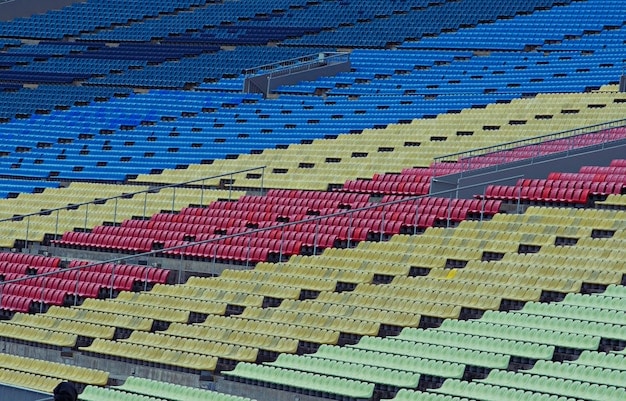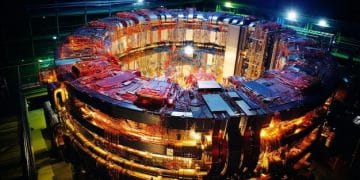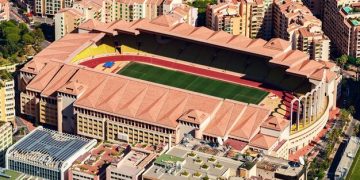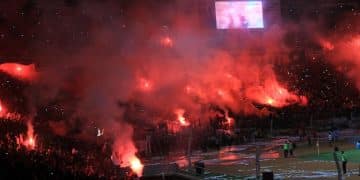La Liga’s Fan Culture: Unveiling Spanish Football Passion & Traditions

La Liga’s fan culture is a vibrant tapestry of passionate supporters, deeply rooted traditions, and unwavering loyalty that shapes the electric atmosphere of Spanish football stadiums.
Immerse yourself in the heart of Spanish football as we explore La Liga’s fan culture, a unique blend of passion, traditions, and unwavering devotion that defines the beautiful game in Spain.
Understanding La Liga: A Brief Overview
La Liga, officially known as the Primera División, stands as Spain’s top professional football division. Renowned globally, it showcases some of the world’s most skilled football clubs and players.
From the electrifying El Clásico between Real Madrid and Barcelona to the regional rivalries that ignite cities, La Liga offers a gripping spectacle on the pitch. However, the allure extends beyond the matches themselves, deeply entwined with a vibrant and passionate fan culture.

The Passion of La Liga Fans
La Liga fans exude a level of passion that is palpable. It’s not merely about supporting a team; it’s an ingrained part of their identity, a connection that spans generations.
This fervor translates into packed stadiums, deafening chants, and unwavering support, turning every match into a spectacle of emotion. But where does this passionate following originate?
Historical Roots of Fan Passion
The intense passion seen in La Liga fan culture extends from a long history, rooted in local pride and identity. Football teams in Spain became symbols of cities and regions, especially during times of political and social change. Their loyalty never wavered.
Family Traditions and Inherited Fandom
For many La Liga fans, supporting their team is a family tradition, passed down from generation to generation. This creates a deep emotional connection and a sense of belonging to something larger than themselves.
- Shared experiences at matches create strong family bonds.
- Children grow up immersed in the culture, learning chants and traditions early on.
- Family history becomes intertwined with the history of the club.
Fans don’t just support a club, they carry on the legacy within it.
The passion of La Liga fans is a force to be reckoned with, driven by historical roots, family traditions, and a profound sense of identity.
Territoriality and Rivalries
Territoriality plays a significant role in La Liga’s fan culture. Teams represent more than just a city; they embody the pride and identity of an entire region.
This regionalism fuels intense rivalries, creating some of the most exciting and eagerly anticipated matches in the world.
El Clásico: Barcelona vs. Real Madrid
El Clásico is more than just a football match; it’s a clash of cultures, ideologies, and histories. It brings a sense of rivalry to a new level; more than just sport-rooted.
Regional Derbies: Sevilla vs. Real Betis
Regional derbies like the Seville derby between Sevilla FC and Real Betis showcase the intense local pride and passion within a single city. The stakes are high, and bragging rights are valuable!
- Derbies often reflect social and political divides within the region.
- The atmosphere at these matches is electric, with fans creating incredible displays of support.
- Winning a derby is often seen as more important than winning other matches.
Territoriality and rivalries add another layer of complexity and excitement to La Liga’s fan culture, making each match a battle for regional pride.
The Rituals and Traditions of Spanish Football
La Liga’s fan culture is rich in rituals and traditions that have been passed down through generations. These traditions enhance the matchday experience and create a sense of community among supporters.
These rituals range from pre-match gatherings to specific chants and songs, adding a personal touch to the electrifying atmosphere only Spanish football can bring.
Pre-Match Traditions: Gathering and Rituals
Before each match, fans gather in local bars and plazas, sharing drinks, food, and passionate discussions about their team. This pre-match ritual is an important part of the social experience.
Songs, Chants, and Displays of Support
La Liga stadiums are filled with the sounds of passionate songs and chants. Fans create elaborate displays of support, including banners, flags, and coordinated displays.
- Each club has its own unique anthem and set of chants.
- Fans take pride in creating original and creative displays.
- The atmosphere created by these displays is often intimidating for opposing teams.
Spanish football showcases rituals rich in tradition, that enhance the match-day experience and create a community among supporters.
Ultras: The Vocal Core
The Ultras are a segment of La Liga’s fan base, known for their vocal, passionate, and often controversial support. They are often at the forefront of creating the atmosphere in stadiums.
While their actions can sometimes be disruptive, they play a significant role in shaping the identity and passion of La Liga’s fan culture.
Origins and Evolution of Ultras Groups
Ultra groups first emerged in Europe in the 1960s and 1970s, inspired by Italian fan culture. They quickly spread to Spain, becoming an integral part of La Liga’s landscape.
Influence on Stadium Atmosphere
Ultra groups are responsible for much of the atmosphere in La Liga stadiums. They lead chants, create displays, and generally act as the vocal core of support.
Controversies and Challenges
Ultra groups have faced criticism for their association with violence, political extremism, and intolerance. Efforts have been made to address these issues and promote a more positive fan culture. Security and regulation are key.
The Role of Social Media and Modern Fandom
Social media has transformed the way fans interact with their clubs and with each other. It can increase connections, and offer new ways to show their support of a team.
While social media can sometimes amplify negativity, it also provides a powerful tool for building community and celebrating the passion of La Liga.
Online Communities and Fan Engagement
Online forums, social media groups, and fan-created websites allow supporters from all over the world to connect and share their passion for La Liga.
Impact on Club Communication and Branding
Clubs use social media to communicate directly with fans, build their brand, and promote their activities. This constant interaction keeps fans engaged.
Combating Online Toxicity and Promoting Positive Interactions
Efforts are being made to combat online toxicity and promote positive interactions among fans. This includes moderating online communities and promoting respectful discourse.
Challenges and the Future of La Liga Fan Culture
La Liga’s fan culture faces challenges such as hooliganism, safety, and evolving fan behavior. Addressing these issues is crucial to sustaining the unique atmosphere while evolving.
By embracing diversity, promoting inclusivity, and fostering safer environments, La Liga can ensure a vibrant and welcoming atmosphere for all who share a passion for the beautiful game.
Addressing Hooliganism and Promoting Safety
Efforts are ongoing to address hooliganism and promote safety in stadiums. This includes increased security, stricter regulations, and educational programs.
Balancing Tradition with Modernization
La Liga faces the challenge of balancing traditional elements of fan culture with modernization. This includes incorporating technology and adapting to changing fan expectations.
Promoting Diversity and Inclusivity
Efforts are being made to promote diversity and inclusivity within La Liga’s fan base. This includes initiatives to welcome fans from all backgrounds and create a more welcoming atmosphere.
| Key Point | Brief Description |
|---|---|
| 🔥 Passionate Support | La Liga fans are known for their intense and unwavering support for their teams. |
| 🤝 Family Traditions | Supporting a team is often passed down through generations, creating a strong sense of belonging. |
| 🏟️ Stadium Atmosphere | La Liga stadiums are known for their electric atmosphere, filled with songs, chants, and displays of support. |
| 📣 Ultras Influence | Ultra groups play a significant role in shaping the atmosphere in stadiums with their vocal support. |
Frequently Asked Questions (FAQ)
▼
La Liga’s fan culture is unique due to its deep-rooted historical connections, intense regional rivalries, and passionate displays of support. It’s a blend of tradition and emotion only found in Spain.
▼
The Ultras are the vocal core of support in La Liga stadiums. They lead chants, create displays, and generate an intimidating atmosphere for opposing teams, contributing to the overall energy.
▼
La Liga is home to famous rivalries, including El Clásico (Barcelona vs. Real Madrid) and regional derbies like Sevilla vs. Real Betis. Each match is filled with local pride and passion.
▼
Social media has allowed fans to connect globally, share their passion, and interact directly with their clubs. It has also created new challenges in combating online toxicity and promoting positive interactions.
▼
Efforts to enhance safety include increased security measures, stricter regulations, and educational programs designed to address hooliganism and promote respectful behavior among supporters.
Conclusion
La Liga’s fan culture is a vibrant and evolving tapestry of passion, traditions, and unwavering support. It presents both challenges and opportunities, but one thing remains certain: it is key in Spanish football.





